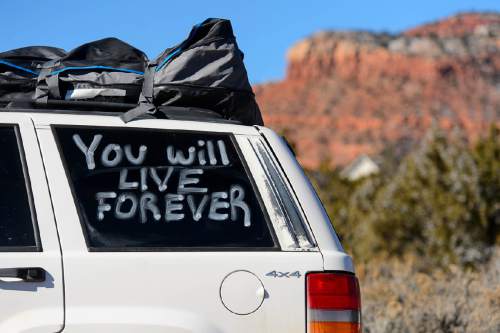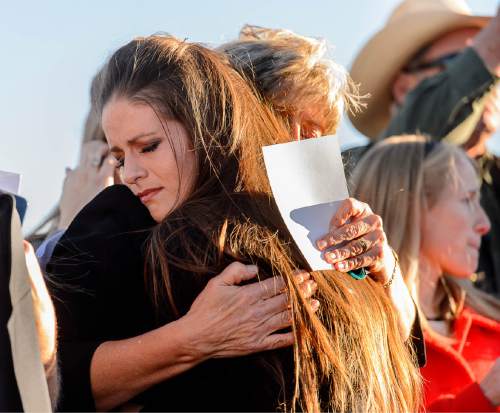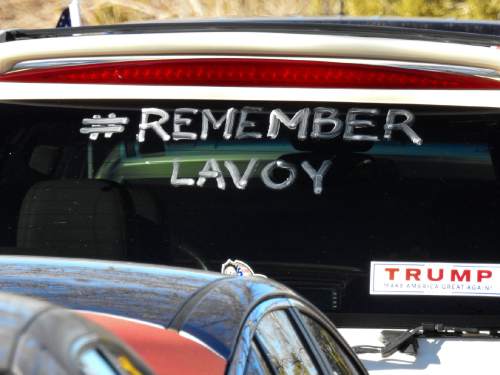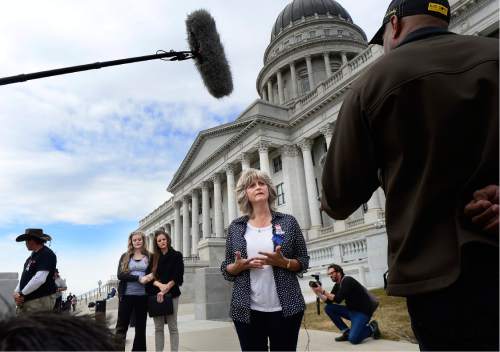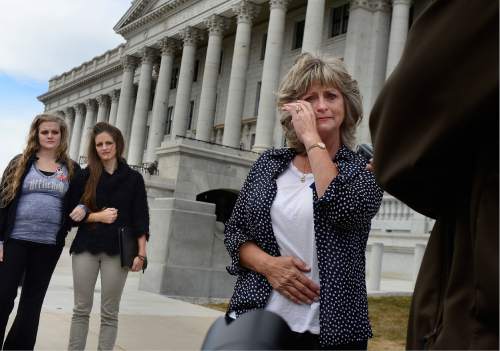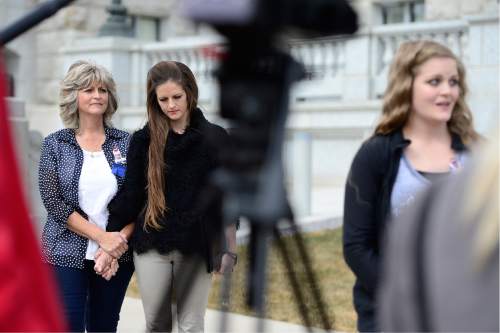This is an archived article that was published on sltrib.com in 2016, and information in the article may be outdated. It is provided only for personal research purposes and may not be reprinted.
Two Oregon state police officers who shot and killed Robert "LaVoy" Finicum noted that during the occupation of a federal bird refuge, Finicum appeared in media armed and resistant to the notion of his arrest.
The Deschutes County Sheriff's Office released 360 pages of reports from its weekslong probe into the Jan. 26 shooting Thursday, including the accounts of two officers who shot Finicum three times at a roadblock on a rural eastern Oregon highway. Investigators found the shooting to be justified, though Finicum's widow referred to their report as a "whitewash" and said she plans to sue.
Among the revelations from seven state police officers involved in that day's operation:
• Two officers accounted for all six shots by Oregon state police, including three shots fired on Finicum's white truck as it approached the roadblock
• Law enforcement feared militia surveillance at the FBI's Burns command post and on scanners, and expected a possible militia response at the roadblock.
• Finicum was known to them for wearing a gun on a shoulder holster and having said things to the effect that he "didn't plan on being taken alive," according to one of the officers who shot him, referred to as Officer No. 2
The other shooter, Officer No. 1, told investigators: "[T]hey put that face of a peaceful relationship between law enforcement and their cause out there, but I also knew that at the end of their statement of being fully peaceful, that they would take defensive actions to include shooting police officers to further their message."
Officer No. 1, who fired five of OSP's six shots, was assigned that day to traffic control north of the roadblock but had returned to the roadblock to talk about possibly relocating it.
Down the road, Finicum pulled away from officers at an initial traffic stop, where the occupants of a second vehicle had been arrested without incident.
Officers at that initial stop radioed ahead that Finicum was headed toward the roadblock and had stated that he'd have to be shot to be deterred from a meeting with Grant County Sheriff Glenn Palmer.
After Finicum's truck rounded a bend in Highway 395, Officer No. 1 said, "it got to a point where I believe without a doubt it could not stop. It was going to run into our roadblock, which would have resulted in the death or serious injury of multiple officers."
Officer No. 1 fired three shots toward the driver and motor as the truck veered off the road into deep snow. Officer No. 1 believed the truck had run over another officer, who might be pinned underneath.
When Finicum exited the truck, Officer No. 1 said, "I anticipated likely being shot at through those windows of that vehicle, and that's based off of all the intelligence reports and the fact that they are armed and now they are committed to the point of running over an officer."
That officer watched as another officer, No. 3, approached Finicum to detain him with nonlethal force. Seeing Finicum reach a third time toward a coat pocket, Officer No. 1 felt "that I needed to take action to stop him from being a threat to Officer No. 3, and at that point I fired two rounds."
Officer No. 2, was part of the pursuit from the initial traffic stop and had hopped out of a truck at the roadblock.
"Just as soon as I pulled my rifle up and put the cross hair on Mr. Finicum, Officer No. 1 fired," Officer No. 2 said.
Officer No. 2 then fired a single round at almost the same moment.
"I believe that if I didn't engage Mr. Finicum, that Officer No. 3 was in a very close proximity and probably would have been shot, and that's what was going through my mind, is that Officer No. 3 was in a very bad spot."
Another officer, No. 4, had removed the safety on the officer's gun and was preparing to fire but chose not to after seeing the effectiveness of the shots fired by Officer Nos. 1 and 2.
The 41-day occupation ended two weeks later, with Utah residents Cox, Dylan Wade Anderson and Wesley Kjar among 26 facing federal charges for their alleged roles.
Days after attending Finicum's Kanab funeral and sharing his view of a rancher's rights on public lands, Cliven Bundy was arrested and charged — now with 18 others — for the 2014 standoff at his Bunkerville ranch.
Some other details from the newly released documents:
• There are no direct references to two shots fired by an agent from the FBI's elite Hostage Rescue Team, now subject of a new probe by the Office of the Inspector General for the Department of Justice because the shots were not initially disclosed to state investigators. But one interaction hints at the state investigators' discovery: After Officer 4 has trouble recalling the name of an FBI agent, an investigator jokes, "[S]ince I've been on this, I'm figurin' out these guys are pretty mysterious." Officer 4 chuckles. "Yeah." Later, Officer 4 is asked if the FBI agents have "ladders" — which might be a guess at how a shot was fired through the truck's roof as Finicum exited.
• Officer No. 1 disclosed that an arrest plan similar to the one used Jan. 26 was called off by the FBI days earlier.
• Officer No. 1 expected from reports that the suspects might have grenades in their arsenal.
• Officer No. 2 observed that a less-lethal sponge tip round compelled Ryan Payne to leave Finicum's truck at the initial traffic stop, after Payne had gotten "half out the truck" and acted like he might re-enter.
• Officer No. 2 heard that an FBI agent was injured.
• In the video shot by Kanab resident Shawna Cox from the back seat of Finicum's truck, Cox and Ryan Bundy do not have cellular service to call Joseph Rice, an Oregon-based militia activist who founded the Pacific Patriot Network. The location was chosen in part for its spotty cellphone service, said Officer No. 4.
• Officer No. 5 said officers had taped light body armor to the door panels in a van for added protection.
• Ryan Bundy told Officer No. 5 he'd been hit in the shoulder. Officer No. 5 cut open his shirt to discover a small hole through three shirts and a small wound about an inch and a half deep. Bundy would later be released from a hospital without treatment.
• Officer No. 6 knew of Ryan Payne as a "hothead" who'd been a training officer for "'The Strike Force,' or something ridiculous like that," and had heard that Brian Cavalier goes by "Booda" and "Fluffy Unicorn" in an "interview where he was wearing a stocking cap with a Velcro patch that said 'Major League Sniper,' which to me is absolutely ridiculous." Officer No. 6 continued: "[T]hat's how he wants people to see him — you know, a dangerous man who is obviously skilled at marksmanship and taking a life. Uh, it's kinda like the guys who wear 'Tap Out' shirts. They may not be fighters, but they want people to believe they are and their personal image revolves around that kind of masculinity, so we assume they would be dangerous to us."
• Officer No. 6 called Finicum's shoulder holster "'80s 'Miami Vice.' "
• Officer No. 6 was "irritated" when Cox asked if Officer No. 6 believed in the Constitution and not about Finicum. "You know, 'cause that's what we want to talk about right now? OK. And then so, I started to walk away. I remember Mr. Payne turning around and mean-mugging me, trying to give me a dirty look like he's a tough guy. And I didn't understand that. Like it's not the time for, you know, your attitude right now."
• Officer No. 8 thought the group had "a sense of empowerment that they could do this and get away with it," because there had been no repercussions for Cliven Bundy's 2014 standoff in Bunkerville, Nev.
Twitter: @matthew_piper


